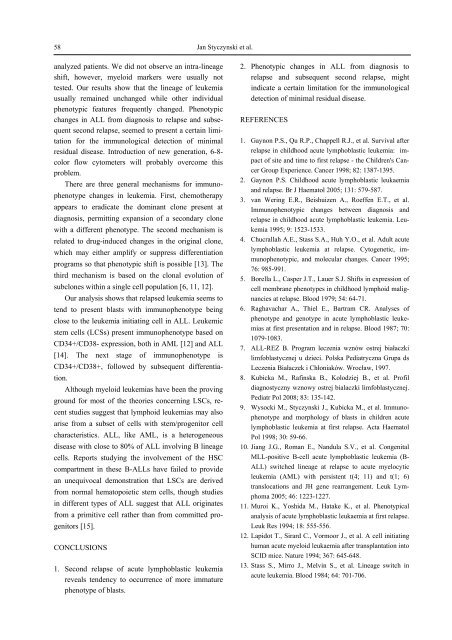medical and biological sciences - Collegium Medicum - Uniwersytet ...
medical and biological sciences - Collegium Medicum - Uniwersytet ...
medical and biological sciences - Collegium Medicum - Uniwersytet ...
You also want an ePaper? Increase the reach of your titles
YUMPU automatically turns print PDFs into web optimized ePapers that Google loves.
58Jan Styczynski et al.analyzed patients. We did not observe an intra-lineageshift, however, myeloid markers were usually nottested. Our results show that the lineage of leukemiausually remained unchanged while other individualphenotypic features frequently changed. Phenotypicchanges in ALL from diagnosis to relapse <strong>and</strong> subsequentsecond relapse, seemed to present a certain limitationfor the immunological detection of minimalresidual disease. Introduction of new generation, 6-8-color flow cytometers will probably overcome thisproblem.There are three general mechanisms for immunophenotypechanges in leukemia. First, chemotherapyappears to eradicate the dominant clone present atdiagnosis, permitting expansion of a secondary clonewith a different phenotype. The second mechanism isrelated to drug-induced changes in the original clone,which may either amplify or suppress differentiationprograms so that phenotypic shift is possible [13]. Thethird mechanism is based on the clonal evolution ofsubclones within a single cell population [6, 11, 12].Our analysis shows that relapsed leukemia seems totend to present blasts with immunophenotype beingclose to the leukemia initiating cell in ALL. Leukemicstem cells (LCSs) present immunophenotype based onCD34+/CD38- expression, both in AML [12] <strong>and</strong> ALL[14]. The next stage of immunophenotype isCD34+/CD38+, followed by subsequent differentiation.Although myeloid leukemias have been the provingground for most of the theories concerning LSCs, recentstudies suggest that lymphoid leukemias may alsoarise from a subset of cells with stem/progenitor cellcharacteristics. ALL, like AML, is a heterogeneousdisease with close to 80% of ALL involving B lineagecells. Reports studying the involvement of the HSCcompartment in these B-ALLs have failed to providean unequivocal demonstration that LSCs are derivedfrom normal hematopoietic stem cells, though studiesin different types of ALL suggest that ALL originatesfrom a primitive cell rather than from committed progenitors[15].CONCLUSIONS1. Second relapse of acute lymphoblastic leukemiareveals tendency to occurrence of more immaturephenotype of blasts.2. Phenotypic changes in ALL from diagnosis torelapse <strong>and</strong> subsequent second relapse, mightindicate a certain limitation for the immunologicaldetection of minimal residual disease.REFERENCES1. Gaynon P.S., Qu R.P., Chappell R.J., et al. Survival afterrelapse in childhood acute lymphoblastic leukemia: impactof site <strong>and</strong> time to first relapse - the Children's CancerGroup Experience. Cancer 1998; 82: 1387-1395.2. Gaynon P.S. Childhood acute lymphoblastic leukaemia<strong>and</strong> relapse. Br J Haematol 2005; 131: 579-587.3. van Wering E.R., Beishuizen A., Roeffen E.T., et al.Immunophenotypic changes between diagnosis <strong>and</strong>relapse in childhood acute lymphoblastic leukemia. Leukemia1995; 9: 1523-1533.4. Chucrallah A.E., Stass S.A., Huh Y.O., et al. Adult acutelymphoblastic leukemia at relapse. Cytogenetic, immunophenotypic,<strong>and</strong> molecular changes. Cancer 1995;76: 985-991.5. Borella L., Casper J.T., Lauer S.J. Shifts in expression ofcell membrane phenotypes in childhood lymphoid malignanciesat relapse. Blood 1979; 54: 64-71.6. Raghavachar A., Thiel E., Bartram CR. Analyses ofphenotype <strong>and</strong> genotype in acute lymphoblastic leukemiasat first presentation <strong>and</strong> in relapse. Blood 1987; 70:1079-1083.7. ALL-REZ B. Program leczenia wznów ostrej białaczkilimfoblastycznej u dzieci. Polska Pediatryczna Grupa dsLeczenia Białaczek i Chłoniaków. Wrocław, 1997.8. Kubicka M., Rafinska B., Kolodziej B., et al. Profildiagnostyczny wznowy ostrej bialaczki limfoblastycznej.Pediatr Pol 2008; 83: 135-142.9. Wysocki M., Styczynski J., Kubicka M., et al. Immunophenotype<strong>and</strong> morphology of blasts in children acutelymphoblastic leukemia at first relapse. Acta HaematolPol 1998; 30: 59-66.10. Jiang J.G., Roman E., N<strong>and</strong>ula S.V., et al. CongenitalMLL-positive B-cell acute lymphoblastic leukemia (B-ALL) switched lineage at relapse to acute myelocyticleukemia (AML) with persistent t(4; 11) <strong>and</strong> t(1; 6)translocations <strong>and</strong> JH gene rearrangement. Leuk Lymphoma2005; 46: 1223-1227.11. Muroi K., Yoshida M., Hatake K., et al. Phenotypicalanalysis of acute lymphoblastic leukaemia at first relapse.Leuk Res 1994; 18: 555-556.12. Lapidot T., Sirard C., Vormoor J., et al. A cell initiatinghuman acute myeloid leukaemia after transplantation intoSCID mice. Nature 1994; 367: 645-648.13. Stass S., Mirro J., Melvin S., et al. Lineage switch inacute leukemia. Blood 1984; 64: 701-706.
















